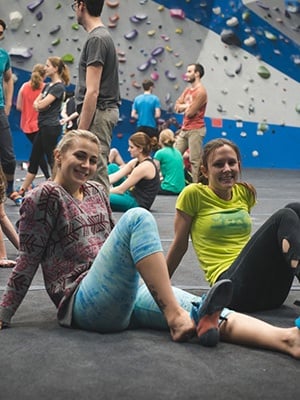The Sendy Times
Expand your climbing knowledge with training tips and tricks from Movement's instructors, trainers, and coaches.

Rock Climbing | Training for Climbing | Climbing Tips
Nothing inspires us to dream big quite like a brand spankin’ new year, am I right? We get inspired; we resolve to make improvements; we set goals. But for some of us, big dreams don’t always translate into sticking with and crushing our goals. That’s why this year, we thought we’d help by laying out some steps you can take right now and later this month to create a routine you can get into and stick with in January 2023 and beyond.

We get a lot of questions about how to climb better and because we are so stoked to see you succeed, we’ve asked our trainers, coaches, and instructors at Movement locations all over the country to provide as much training, technique, and fitness advice to help you achieve your goals. But what is a good goal? Who are climbing goals for—are those only for those who’ve been climbing for a while? How do you make a good goal? In all parts of life goals can give us a clearer path toward the outcomes we desire. In climbing, goals can help you focus and approach your gym sessions with more intention. You’ll make the most of your time at the gym while on your way to crushing your objective, whether it’s to climb one route at a certain grade, feel comfortable climbing most routes at a certain grade, send a certain route, you get the idea. So instead of more general climbing tips and tricks, let’s take a step back and look into how to craft a climbing goal made specifically for you by you.

Get the latest climbing news, tips and tricks straight to your inbox.

Training for Climbing | Climbing Tips
By: Kim
Do you practice failing? Probably not. Let’s be honest – failure is hard for a lot of us, especially if you’ve been conditioned to think of failure as a bad thing.

Training for Climbing | Fitness and Yoga
By: Dan Umbreit
If you’re guilty of climbing one “easy” route, jumping on your project once or twice and then heading home, this blog is for you. Warming up gets the blood flowing and raises your body's temperature. It's critical to preventing injury, increasing mental focus, and getting the body primed for producing force to try hard. Conversely, what you do AFTER climbing can be just as important as your warm-up before. An effective cool-down routine releases the muscles, slows your breath, and jumpstarts the recovery process.

Training for Climbing | Fitness and Yoga
By: Aaron Neal
A pistol squat is an exercise that is very easy to explain, but hard for most people to do. From a standing position, shift your weight to one leg while the other leg shoots forward. From there, you squat down, bringing your tailbone to your heel and then stand up from a seated or squat position, again only using one leg. Pistol squats are great for increasing leg strength and improving balance, which means they really give you a leg up in your climbing.

Training for Climbing | Fitness and Yoga
Climbing requires a lot of overhead shoulder and arm movement and can put quite a bit of stress on the shoulders. All of this strain can lead to injuries ranging from minor muscle tweaks to major tendon tears. The good news is there are a few very effective exercises that strengthen the shoulder and prevent injuries.

Training for Climbing | Fitness and Yoga
By: Francy Schuldies
From weight shifting on a slabby route, to long approaches or summer hikes, to everything in between, the legs are the powerhouse of climbing. We talked to Francy at our Englewood gym in Colorado. She is one of the personal trainers there and teaches a weekly Ski Fit class, so we figured that if anyone could recommend a thorough workout to strengthen their bottom half, it would be her 😆. Enjoy!

By: Elliott Carlson
Campus board workouts are a great way to build upper body strength and improve climbing power. Incorporating these kinds of workouts into your routine can improve finger strength and make powerful or dynamic moves easier. Here's a great workout one of our staff members created that you can incorporate into your climbing routine.

By: Lucas Klein
One of the training questions we get all the time is when should I start using training boards, like a campus board, and how do I start. Campus board workouts are a great way to improve climbing power and strength. When to start very much depends on the climber, but in general, we recommend waiting until you've been climbing consistently for at least one year (meaning, you're consistently climbing twice a week for 1-2 hours). As far as how to start, one of our staff members has provided a beginner campus board workout that would be a great one to incorporate in your climbing routine. Keep in mind that while it may be considered a "beginner" workout, it is not easy! Please make sure that any training board workout sessions are done after warming up thoroughly, but before any climbing or other heavy physical workout.

By: Abby Neal
Hangboards are great for building hand and finger strength. A good hangboard workout will give you the opportunity to practice on a variety of holds, which will improve your lock off strength, and engage shoulder stabilizer muscles that probably don't get much action during your regular climbing sessions. Ideally, these two exercises we provide below are something you do once or twice a week to supplement your climbing session. Keep in mind that while it may be considered a "beginner" workout, it is not easy! We do not recommend using this equipment unless you have at least one year of climbing under your belt (meaning, you're consistently climbing twice a week for 1-2 hours). Please make sure that any training board workout sessions are done after warming up thoroughly, but before any climbing or other heavy physical workout.